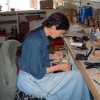Search the Community
Showing results for tags 'hayden duet tutorial'.
-
Chapter eight of Judy's harum scarum Hayden tutorial ---------------- Section One ----------------- Ok, finally on to harmonization. There's no one right way to harmonize anything: just what sounds best to you. But that's hard to figure out, so you have to begin somewhere. The easiest starting point is just to play the root note of the key -- G -- in the left hand, on the first note of every measure. That way you are keeping the rhythm very clear (dancers like that!) and getting some practice with your left hand operating in a different pattern from your right hand. While you're doing that, listen to what you are playing and think about when it sounds good, when it doesn't sound so good, and how it gets pretty tedious after a while. Either on paper, or in your head, make a map of the tune to keep track of when "G" sounded good and when it didn't. Having learned the tune all broken up into tunelets can help you to have a map in your head-- "I liked G with the first tunelet, but not the second... " -------------------------- Now that you have a bit of an idea of where you like the G, and where you don't, here's some ideas for other notes besides G. The easiest way is to get ideas from someone else. In the Waltz Book, there are chords written -- just the letter names. A straight forward starting point is to play the letters written (ignoring all puzzling qualifiers like "7" and "6" and /B and m, which I'll get into later). Here's the abc: X:1 T:Tombigbee Waltz S:The Waltz Book, Bill Matthieson M:3/4 L:1/4 K:G B/A/ || "G"GBB | "(GM7)"d2 B/A/| "(G6)"GBB | "G"d2 B |\ "Am"BAA | ABd | "C"e2 d | "D7"B>c B/A/ | "G"GBB | "(GM7)"d2 B/A/| "(G6)"GBB | "G"d2 B |\ "Am"BAA | ABd | "C"ed "D"F | "G"G2 d || "G"g2d | "G/B"g2 d | "C"e>dc | "G"d2 B |\ "Am"BAA | ABd | "C"e2 d | "D"B2 d | "G"g2d | "G/B"g2 d | "C"e>dc | "G"d2 B |\ "Am"BAA | ABd | "C"ed "D"F | "G"G2 || Get really comfortable with using the letter names of the chords to create a left hand. As you play, listen for which left-hand notes sound really good, and which ones don't sound as good. Once you've gotten comfortable with that, try this: for those left-hand notes which DON'T sound so good to you, substitute a different note IN THE SAME CHORD. .....what's a chord? .....the most BASIC definition of a chord is any group of notes sounding at the same time.... kind of like "a word is a group of letters" (but not just any random group of letters!) So: there's groups of letters which mean something; and there's groups of specific notes that have a good sound, and have names. For example: the G major chord is GBD all sounded at once. Similarly, the C major chord is CEG all sounded at once. Play the G chord. Play the C chord. Observe how they are the same pattern, just shifted to a different part of the button map. Back to the tune: if it says "C" over the melody, but if you've decided you don't particularly like how the C sounds with that part of the melody, try the E. As you experiment with that, notice how easy it is to find the 'next note up" in the chord. Here's a list of chords used with Tombigbee, spelled out: "G" G B D "GM7" G B D F# "G6" G B D E "Am" A C E "C" C E G "D7" D F# A C "G/B" means either a G major chord, or a B chord, which would be B D# F# I think you have plenty to work with at this point. If it feels overwhelmingly too many notes to deal with, go back a bit: play just the note names as written in the sheet music, or even just the G. Move back and forth between what's comfortable, and what's more difficult. Keep building up that map in your mind, the map that helps you remember where G (or C, or F# ) in the left hand sounds good and where it doesn't sound so good. ------------------------------------------------------------- All of the above -- all the way back to breaking up the tune into tunelets and learning them -- is stuff you can apply on your own to any tune out there. Try it! Next few chapters I'll get into some more different possiblities with chords in the left hand.

